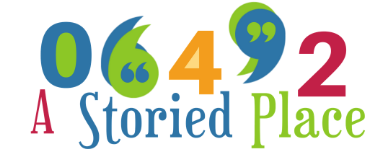Community memory can be created in the public exchange of story. Sharing. Listening. Asking Questions. Exploring a common bond. My first community overshadows my current community with memories more fragile with each passing year. Sometimes I explore the dissonance and lack of connection I feel with the feeling of home expressed in poems or blogs. How can Wallingford, as captured in the poem, Here feel more like home?
My Roots: Windsor, CT
Windsor lays claim to being the first settlement in Connecticut. It is where an interstate cuts north and south and meandering rivers still meet. Each year there is ‘Shad Derby Day’ for all, not just those with a fishing line over the bridge. In my youth, there was a movie marquee and an in-town business boasting 31 ice cream flavors. In the numerous park ponds, ripples still attracted striders and dragonflies. For me, home lingers like the smell of fresh ground coffee where we shopped at the A&P.
Some small truths: My first awareness of the world was from inside a tobacco barn where immigrant workers straddled the heat and the rafters. My first encounter with infamy was the names of my public elementary schools: John Fitch and John Kennedy. Like Wallingford, there is also an evolved story of a private school for boys and girls, which merged to remain a dipstick for courageous intellect. Memories flicker linking to stories of aspiring to places bigger than where Native American Indians once lived or youth gathered day and night in spaces set aside for structured gathering.
My residence: Wallingford,CT
My fourth relocation within Connecticut was where the parkway cuts north and south
and an esplanade traverses one of many hilltops aside my front lawn. I chose relocation here based on a few prior positive encounters with the community. A decade before, I was a welcomed presenter among civic-minded women. I traveled this rustic parkway rather than the interstate from my work in North Haven to a satellite office at a quaint repurposed foundry in Wallingford. From a neighboring farm community, my children had double-hitter summers at Indian Y Camp, and were enchanted by the library with a community TV station inside. They loved both. Memories turned out to be more like misperception.
My Community Service Re-Entry
Wandering the booths of Celebrate, or Taste of Wallingford Day, reacquaints me with prospects of hyper-local service. However, person-to-person encounters across The Parade Ground, in schoolyards and along the Quinnipiac Trail became false positives. I am quickly disillusioned. I join the Dag Hammarskjold Middle School PTAC to quickly realize neither the staff nor the long serving PTAC members are familiar with Markings Dag Hammarskjold’s journal published after his death. What he referred to as “a White Book concerning my negotiations with myself – and with God,” was a coming of age text for me. There was growing evidence that I wrongly assumed a community with a school bearing his name would be globally aware and progressive in the sense of his quote “Never measure the height of a mountain until you have reached the top. Then you will see how low it was.”
I delay affirming solicitations to become involved in an organization called WPAA Cable 18 once I came to understand that the public library, which in my opinion was maimed, was no longer housing the Community TV station over a controversy about parodies. The purchase appeal of my home with nearby walk-to-school paths was overshadowed by the promise of the regional arts academy for the education of my son who ultimately went to college after sophomore year. A state-wide performance arts organization to which I belonged was interested in central Connecticut venues but was not allowed to use the library nor promote poetry slam events at Planet Bean, a local coffee shop, on its bulletin board. The coffee shop’s regular patrons emptied out as the poets of color entered. I began to wonder what somersaulted this community into darkness. Or if I truly misread all the clues I had gathered in visits a decade earlier when invited here to speak.
I revisited Markings and the resounding message was “It is when we all play safe that we create a world of utmost insecurity … Never, for the sake of peace and quiet, deny your own experience or convictions.”
Be Freeman
Be Freeman ostensibly is about being in the world based on convictions about democracy. Hammarskjöld, the second Secretary-General of the United Nations, and posthumous awardee of the Nobel Peace Prize, models this as he contemplates love, justice, devotion, morality, and empathy. He explores the relationship between self and the ‘other’ and concludes that he will be grateful for being allowed to listen, to observe, and to understand others. To break barriers with others, all of these interpersonal skills must be called upon. Not an easy calling.
As I commit to keeping a door open to all for free speech, my midlife becomes consumed with powerful, wild and free engagement: a blue chicken, a repurposed barn, several skirmishes with the Mayor and bouts of negativity. I remain in order ‘To be the change I want to see in the world.’ One encounter at a time, new stories begin to transform my life, and optimistically, maybe my community. Maybe someday I will not feel discomfort calling Wallingford ‘home.’
